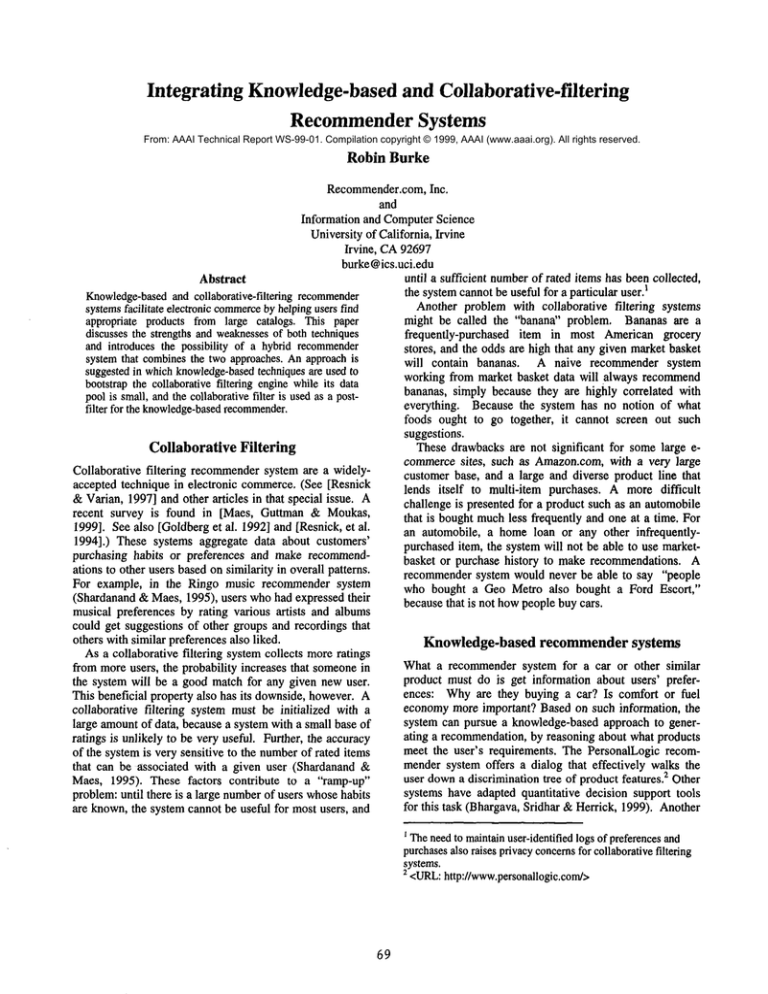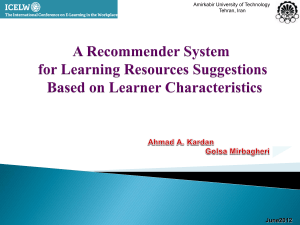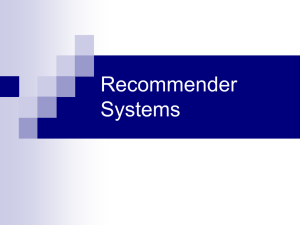Integrating Knowledge-based and Collaborative-filtering Recommender Systems
advertisement

Integrating Knowledge-basedand Collaborative-filtering Recommender Systems From: AAAI Technical Report WS-99-01. Compilation copyright © 1999, AAAI (www.aaai.org). All rights reserved. Robin Burke Recommender.com,Inc. and Information and ComputerScience Universityof California, Irvine Irvine, CA92697 burke@ics.uci.edu until a sufficient numberof rated items has been collected, Abstract the systemcannot be useful for a particular user) Knowledge-based and collaborative-filtering recommender Another problem with collaborative filtering systems systemsfacilitate electronic commerce by helpingusers find appropriate products from large catalogs. This paper might be called the "banana" problem. Bananas are a discusses the strengths and weaknessesof both techniques frequently-purchased item in most American grocery and introduces the possibility of a hybrid recommender stores, and the odds are high that any given market basket systemthat combinesthe two approaches. Anapproachis will contain bananas. A naive recommender system suggestedin whichknowledge-based techniquesare used to working from market basket data will always recommend bootstrapthe collaborativefiltering enginewhileits data bananas, simply because they are highly correlated with poolis small, andthe collaborativefilter is usedas a posteverything. Because the system has no notion of what filter for the knowledge-based recommender. foods ought to go together, it cannot screen out such suggestions. Collaborative Filtering These drawbacksare not significant for somelarge ecommercesites, such as Amazon.corn, with a very large Collaborative filtering recommendersystem are a widelycustomer base, and a large and diverse product line that accepted technique in electronic commerce.(See [Resnick lends itself to multi-item purchases. A more difficult &Varian, 1997] and other articles in that special issue. A challenge is presented for a product such as an automobile recent survey is found in [Maes, Guttman & Moukas, that is bought muchless frequently and one at a time. For 1999]. See also [Goldberget al. 1992] and [Resnick, et al. an automobile, a home loan or any other infrequently1994].) These systems aggregate data about customers’ purchased item, the system will not be able to use marketpurchasing habits or preferences and make recommendbasket or purchase history to make recommendations. A ations to other users basedon similarity in overall patterns. recommendersystem would never be able to say "people For example, in the Ringo music recommender system who bought a Geo Metro also bought a Ford Escort," (Shardanand & Maes, 1995), users whohad expressed their because that is not howpeople buy cars. musical preferences by rating various artists and albums could get suggestions of other groups and recordings that others with similar preferences also liked. Knowledge-based recommender systems As a collaborative filtering system collects moreratings What a recommendersystem for a car or other similar from more users, the probability increases that someonein product must do is get information about users’ preferthe system will be a good match for any given new user. ences: Whyare they buying a car? Is comfort or fuel This beneficial property also has its downside, however.A economymore important? Based on such information, the collaborative filtering system must be initialized with a system can pursue a knowledge-based approach to generlarge amountof data, because a system with a small base of ating a recommendation,by reasoning about what products ratings is unlikely to be very useful. Further, the accuracy meet the user’s requirements. The PersonalLogic recomof the systemis very sensitive to the numberof rated items mendersystem offers a dialog that effectively walks the that can be associated with a given user (Shardanand user downa discrimination tree of product features. 2 Other Maes, 1995). These factors contribute to a "ramp-up" systems have adapted quantitative decision support tools problem:until there is a large numberof users whosehabits for this task (Bhargava, Sridhar &Herrick, 1999). Another are known,the system cannot be useful for most users, and 1 Theneedto maintainuser-identifiedlogs of preferencesand purchasesalso raises privacyconcernsfor collaborativefiltering systems. 2 <URL:http://www.personailogic.com/> 69 Technique Knowledgebased Collaborative filtering Ideal Hybrid Pluses A. No ramp-up required B. Detailed qualitative preference feedback (in FindMe systems) C. Sensitive to short-term variance (drift) D. Canidentify niches precisely. E. Domainknowledge not needed. F. Quality improvesover time. G. Personalized recommendations. Minuses H. Knowledgeengineering. I. Suggestionability is static. A, B, C, D, F, G H J. Quality dependenton large historical data set. K. Subject to statistical anomaliesin data. L. Reacts slowly to drift Table 1: Tradeoffs between knowledge-basedand collaborative-filtering class of systems draws from research in case-based reasoning. The restaurant recommenderEntree I (Burke, Hammond & Cooper, 1996) makes its recommendations by finding restaurants in a newcity similar to restaurants the user knowsand likes. The system allows users to navigate by stating their preferences with respect to a given restaurant, refining their search criteria. A knowledge-based recommendersystem avoids some of the drawbacks mentioned above: it does not have a rampup problem since its recommendationsdo not depend on a base of user ratings. It does not have to gather information about a particular user becauseits similarity judgementsare independent of individual tastes. Because its recommendations are based on knowledgeof the product domain, it is immune to statistical anomaliesin marketbaskets. FindMe systems Entree is an exampleof what is knownas a FindMesystem (Burke, Hammond & Young, 1997). FindMe systems have the following distinguishing characteristics as recommender systems. ¯ They are primarily example-based. Users can easily find new products similar to ones with which they are already familiar. ¯ Theyallow the user to critique a suggestion, and try to find similar productsthat satisfy the critique. ¯ They rank products based on the expected goals of users, such as cost-effectiveness, and return a small numberof highly-rated products. FindMesystems effectively offer a web of products, in which the links are product-dependent critiques, such as "Less $$" or "Moretraditional" cuisine, in the case of restaurants. For example,if the user finds a restaurant that looks goodbut finds it is too expensive, he can select the "Less $$" button and be directed to other restaurants that are similar, but lowercost. A particular benefit of FindMe systems is that they enable relatively painless gathering of preference informationwithout requiring that users makeall of their criteria i <URL: http:llinfolab.ils.nwu.edu/entree/> 7O recommender systems. explicit. Rather than requiring the user to input his or her preferences as a starting point, FindMesystems let the user browse through a catalog using qualitative ratings as navigation aids. Each navigation step informs the system about theuser’s preferences at a finer grain of detail than a binary "buy" decision can, and a user is likely to make several (typically 3 in Entree) such navigation steps while using the system, increasing the amountof information that can be gathered. Another benefit of FindMesystems is that performance does not suffer if the user’s interests drift. A moviebuff whousually likes classic film noir will find a well-tuned collaborative filtering systemless useful whenhe seeks out movies for his children. A FindMe system works from whateverstarting point it is given and reacts to the user’s preferencesat that time. Knowledge Engineering Knowledge-based recommendersystems do require knowledge engineeringwith all of its attendant difficulties. For a system to makegood recommendations, it must understand what features of products matter. It must have access to a product database in which those features are readily discernable or at least inferable. In FindMesystems, we have found this necessity substantial but not onerous. For example, the VintageExchange FindMe recommender system for wines (Burke, 1999) required approximatelyone person-monthof knowledgeengineering effort. Both Entree and VintageExchange also required significant data cleaning and natural languageprocessing to render database entries useful. In Entree, cross-reference data (such lists of all restaurants offering Sundaybrunch) were inverted to create per-restaurant feature sets. Restaurant reviews were also processed for key words and phrases. Combining recommendation techniques Table 1 contrasts the collaborative filtering and knowledgebased approaches, identifying the positive and negative aspects of each. The third row suggests what might be achieved in an ideal hybrid that combinesthe techniques. Despite the necessary investment in knowledge engineering, such a hybrid offers good performance even with little or no user data, and the benefits of collaborative filtering as data is collected. The possible synergy with FindMesystems appears particularly promising, since these systems, through preference-based browsing, permit the collection of detailed user ratings even for rarely-purchased items like automobiles. Achieving integration of these techniques is an interesting challenge problemfor the field of recommender systems. There are numerouspossibilities to be explored. At Recommender.corn, we are currently developing FindMe technology for commercial applications and are exploring one such hybrid approach, as outlined in the rest of this paper. Cascaded recommendations A FindMesystem essentially performs an alphabetic sort over the space of products, ranking themaccording to a set of prioritized similarity metrics ~0-Mn. (For a full description of the FindMe algorithm, see [Burke, Hammond & Young,1997].) The result is an ordered set of buckets 130-Bin, equivalence classes of products that are considered equally good suggestions based on the user’s input. A fixed numberof the topmost items are returned to the user. Often, similarity measuresfail to discriminate the returned items completely. The system must arbitrarily return 10 items, for example,out of a bucket 130 of size 15 or 20. In such a case, we consider the result "under-discriminated." The complete elimination of under-discriminated results in FindMesystems is difficult because it requires the addition of more similarity metrics, with attendant knowledge-engineering tasks. Collaborative filtering, however, can add additional discrimination without requiring knowledgeengineering. At an abstract level, there are four different kinds of preference information that a FindMesystem collects from users: Entry point: The item that the user chooses as a starting point can be considered a strongly positive preference, since the user is lookingfor somethingsimilar to it. Endingpoint: The final selection or buying decision can also be considereda positive rating. Tweaking:Whena user critiques a returned item and moveson to something different, we can consider this a negative rating. Browsing:If the user navigates to other items in the returned set, we can consider this a weaknegative rating: if the user truly liked the item he or she wouldprobably not browsefurther. These heuristics are somewhat weak, since we sometimesfind users whoare exploring the system to see what it can do, applying tweaks not to get a specific recommendation, but to see what will come back. However, we believe they form a reasonable first 71 approximation of the notion of a "rating" within the FindMecontext. Let us assume that, in addition to the FindMe recommender system, there is also a collaborative filtering engine available, where ratings are obtained for each item that the user encounters in a FindMesession using the simplified rating scheme given above, and applying standard correlation techniques. Werefer to this as a single-scale filter or SSfilter. Using it, we can derive similar ratings from all of the user’s action, look for similarities across users, and return previously-unseen items in a standard collaborative filtering manner. The operation of the SS filter is likely to be weakif it starts with a small amountof data, so we wouldnot want to present its suggestions directly to users. However,there is little risk of makinga bad suggestion if we use only those ratings of the items in the topmost under-discriminated bucket 130. Wecan go though each item bj in such a bucket and attempt to classify it into high or low preference category based on the user’s interaction so far. These categories can then to be used to discriminate the contents of 130. Intuitively, all other things being equal, we will prefer to recommend bj, if the acceptance of that recommendationwould make the user similar to some set of other users, and prefer not to recommendan item if similar users navigated away from it in the past. In the worst case, if the ratings from the SS filter are uninformative, we will still be selecting items that are equally similar as far as our knowledge-basedsystem is concerned, so the technique can do no harm. This would be a cascade from FindMeto the SS filter, where the collaborative filter is only used after the knowledge-based system has done its work. This design wouldpotentially get us part of the waytoward the ideal hybrid discussed above. A system designed in this way wouldhave all of the benefits of the FindMesystem, but its quality wouldimproveover time in a personalized way. Consider the following example: Alice connects to a version of Entree that includes the collaborative filtering component.She registers as a newuser, and starts browsing for Chicagorestaurants by entering the nameof her favorite restaurant at home, Greens Restaurant in San Francisco. Greens is characterized as serving "Californian Vegetarian" cuisine. The top recommendationis 302 West, which serves "Californian Seafood."It turns out that Alice is, in fact, a vegetarian, so she critiques the system’scuisine choice and movesback towards vegetarian recommendations. After the systemhas built up a bigger user base, another new user Ben approaches the system with the same starting point: Greens. Since the recommendationgiven to Alice was under-discriminated, and her feedback and that of other users allows the system to more fully discriminate Ben’s recommendation, and return Jane’s, a vegetarian restaurant, preferring it over 302West. This thought experiment suggests that a cascade using both knowledge-based and collaborative-filtering techniques may produce a recommendersystem with many of the characteristics of an ideal hybrid. Initial suggestionsare good, since there is a knowledge-baseto rely on. As the system’s database of ratings increases, it can movebeyond the knowledgebase to characterize users more precisely. Because the knowledgebase is always present, users are not trapped by their past behavior. If Alice decides to stop being a vegetarian, she will be able to get recommendations for steakhouses. Collaborative filtering of critiques The technique discussed above takes into account only a coarse representation of a user’s search through the FindMe system and does not take into account the specific nature of the critiques that the user makes of the system’s suggestions. Wecan use these critiques by thinking of them as multi-dimensional ratings on different scales. Wesplit up a user’s ratings into segments:those restaurants that the user thought were too expensive, too quiet, too conservative, etc. Our comparison of users can thus becomemore global identifying others whonot only liked the same things, but also disliked the same things for the same reasons. We anticipate improved recommendationsagainst this data, discovering for examplethat user whothought Yoshi’s Cafe was too expensive often liked Lulu’s. Weanticipate strong clusters in the data: for example, "cheapskates" and "epicures" who would regularly apply "cheaper" and "better" tweaks, respectively. However, this technique increases the sparseness of the rating data, so only empirical evaluation will determine if it will provide an improvementover the rougher single-scale approach. The Entree restaurant guide has been under continuous public operation since August 1996. The HTYP logs of its operation are forming the basis for our first experiments with these ideas. The logs record interactions with over 20,000 unique users (as identified by IP address) rating about 1,000 restaurants. Conclusion Knowledge-basedand collaborative-filtering recommender systems each have distinctive properties that lend themselves to electronic commerce.Wehave suggested that the integration of these techniques is an important unsolved problem in the area of recommender systems. Wehave shownone approach to the construction of a hybrid system, within the context of FindMearchitecture, and shownhow synergy between the techniques might be achieved. The hybrid approaches discussed here do not capitalize on the full powerof collaborative filtering, which, in its pure form, permits the discovery of niche groups of consumers who share tastes. Our approach to filtering would only make itself felt in cases where the existing knowledge-based system was discriminating poorly. Further research will be needed to explore other hybrid recommendation schemes. 72 References Bhargava, H. K., Sridhar, S. and Herrick, C. 1999. Beyond Spreadsheets: Tools for Building Decision Support Systems. IEEEComputer, 32(3) 31-39. Burke, R, 1999. The Wasabi Personal Shopper: A CaseBased RecommenderSystem. Submitted to the 11~ Annual Conference on Innovative Applications of Artificial Intelligence. Burke, R., Hammond,K. & Cooper, E. 1996. Knowledgebased navigation of complex information spaces. In Proceedings of the 13th National Conferenceon Artificial Intelligence, 462-468, MenloPark, CA: AAAIPress. Burke, R., Hammond,K., and Young, B. The FindMe Approachto Assisted Browsing, IEEEExpert, 12(4), pages 32-40, 1997. Goldberg, D., Nichols, D., Oki, B. M., Terry, D. 1992. Using collaborative filtering to weave an information tapestry. Communications of the A CM,35(12) 61-70. Maes, P., Guttman, R. H., and Moukas,A. G. 1999. Agents that buy and sell. Communicationsof the ACM,42(3), 8191. Resnick, P., Iacovou, N., Suchak, M., Bergstrom, P., and Riedl, J. GroupLens:an open architecture for collaborative filtering of netnews. In CSCW94: Proceedings of the conference on Computersupported cooperative work, 175186. NewYork: ACMPress. Resnick, P. and Varian, H. R. 1997. Recommender systems. Communicationsof the A CM,40(3) 56-58. Shardanand, U. and Maes, P. 1995. Social information filtering algorithms for automating "word of mouth" In CHI-95: Conference proceedings on Humanfactors in computing systems, 210-217. NewYork: ACMPress.


